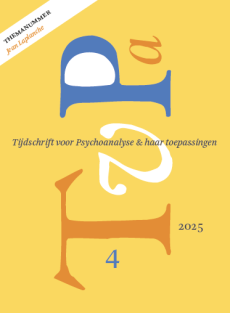Gedachten over psychoanalytische supervisie
Summary
The author discusses some aspects of the supervisory process in teaching psychoanalysis and psychoanalytic psychotherapy. Common problems in this process arise from unconscious transference-countertransference interactions between the patient and his therapist and between the therapist/supervisee and his supervisor. The supervisor-supervisee relationship is complicated by the need to evaluate the supervisee’s work.
Clear learning goals and continual, reciprocal evaluation enhance the working alliance and the learning process.
Because psychotherapists use their own personality as the main instrument in the psychotherapeutic process, maximal investment in the personal development of the trainee, preferably by psychoanalysis, is essential.
Literatuur
- Jacobs, D., P. David, D.J. Meyer (1995), The Supervisory Encounter. Yale University Press, New Haven/Londen.
- Fleming, J., T.F. Benedek (1983), Psychoanalytic Supervision, International Universities Press, Madison.
- Frijling-Schreuder, E.C.M. (1970), On Individual Supervision, International Journal of Psycho-Analysis 51, p. 363-370.
- Haesler, L. (1993), Adequate distance in the relationship between supervisor and supervisee. International Journal of Psycho-Analysis 74, p. 547-555.
- Kantrowitz, J.L., N.L. Katz, D.A. Greenman, H. Morris, F. Paolitto, J. Sashin and L. Solomon (1989), The patient-analyst match and the outcome of psychoanalysis: a pilot study. Journal of the American Psychoanalytical Association 37, p. 893-919.
- Kantrowitz, J.L. (1997), A different perspective on the therapeutic process: the impact of the patient on the analyst. Journal of the American Psychoanalytical Association 45, p. 127-153.
- Szecsödy, I. (1990), Supervision: A Didactic Or Mutative Situation. Psychoanalytic Psychotherapy 4 (3), p. 245-261.
- Szecsödy, I. (1994), Supervision – a complex tool for psychoanalytic training. Scandinavian Psychoanalytical Review; 17, p. 119-129.
- Szecsödy, I. (1997), (How) is learning possible in supervision? In: B. Martindale (Ed.), Supervision and its vicissitudes. Karnac Books, Londen, p. 101-117.
- Vlietstra, D. (1995), Report on Supervision, opinions of candidates. Niet gepubliceerd verslag.
- Wallerstein, R.S. (1981), Becoming a Psychoanalyst, a study of Psychoanalytic Supervision. International Universities Press, New York.
 © 2009-2025 Uitgeverij Boom Amsterdam
© 2009-2025 Uitgeverij Boom Amsterdam
ISSN 1382-516x
De artikelen uit de (online)tijdschriften van Uitgeverij Boom zijn auteursrechtelijk beschermd. U kunt er natuurlijk uit citeren (voorzien van een bronvermelding) maar voor reproductie in welke vorm dan ook moet toestemming aan de uitgever worden gevraagd:
Behoudens de in of krachtens de Auteurswet van 1912 gestelde uitzonderingen mag niets uit deze uitgave worden verveelvoudigd, opgeslagen in een geautomatiseerd gegevensbestand, of openbaar gemaakt, in enige vorm of op enige wijze, hetzij elektronisch, mechanisch door fotokopieën, opnamen of enig andere manier, zonder voorafgaande schriftelijke toestemming van de uitgever.
Voor zover het maken van kopieën uit deze uitgave is toegestaan op grond van artikelen 16h t/m 16m Auteurswet 1912 jo. Besluit van 27 november 2002, Stb 575, dient men de daarvoor wettelijk verschuldigde vergoeding te voldoen aan de Stichting Reprorecht te Hoofddorp (postbus 3060, 2130 KB, www.reprorecht.nl) of contact op te nemen met de uitgever voor het treffen van een rechtstreekse regeling in de zin van art. 16l, vijfde lid, Auteurswet 1912.
Voor het overnemen van gedeelte(n) uit deze uitgave in bloemlezingen, readers en andere compilatiewerken (artikel 16, Auteurswet 1912) kan men zich wenden tot de Stichting PRO (Stichting Publicatie- en Reproductierechten, postbus 3060, 2130 KB Hoofddorp, www.cedar.nl/pro).
No part of this book may be reproduced in any way whatsoever without the written permission of the publisher.
Nieuwsbrief Boom Psychologie
Meld u nu aan en ontvang maandelijks de Boom Psychologie nieuwsbrief met aantrekkelijke aanbiedingen en de nieuwe uitgaven.
Aanmelden


